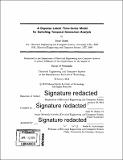A Bayesian latent time-series model for switching temporal interaction analysis
Author(s)
Dzunic, Zoran, Ph. D. Massachusetts Institute of Technology
DownloadFull printable version (19.24Mb)
Other Contributors
Massachusetts Institute of Technology. Department of Electrical Engineering and Computer Science.
Advisor
John W. Fisher III.
Terms of use
Metadata
Show full item recordAbstract
We introduce a Bayesian discrete-time framework for switching-interaction analysis under uncertainty, in which latent interactions, switching pattern and signal states and dynamics are inferred from noisy and possibly missing observations of these signals. We propose reasoning over posterior distribution of these latent variables as a means of combating and characterizing uncertainty. This approach also allows for answering a variety of questions probabilistically, which is suitable for exploratory pattern discovery and post-analysis by human experts. This framework is based on a Bayesian learning of the structure of a switching dynamic Bayesian network (DBN) and utilizes a states-pace approach to allow for noisy observations and missing data. It generalizes the autoregressive switching interaction model of Siracusa et al. [50], which does not allow observation noise, and the switching linear dynamic system model of Fox et al. [16], which does not infer interactions among signals. We develop a Gibbs sampling inference procedure, which is particularly efficient in the case of linear Gaussian dynamics and observation models. We use a modular prior over structures and a bound on the number of parent sets per signal to reduce the number of structures to consider from super-exponential to polynomial. We provide a procedure for setting the parameters of the prior and initializing latent variables that leads to a successful application of the inference algorithm in practice, and leaves only few general parameters to be set by the user. A detailed analysis of the computational and memory complexity of each step of the algorithm is also provided. We demonstrate the utility of our framework on different types of data. Different benefits of the proposed approach are illustrated using synthetic data. Most real data do not contain annotation of interactions. To demonstrate the ability of the algorithm to infer interactions and the switching pattern from time-series data in a realistic setting, joystick data is created, which is a controlled, human-generated data that implies ground truth annotations by design. Climate data is a real data used to illustrate the variety of applications and types of analyses enabled by the developed methodology. Finally, we apply the developed model to the problem of structural health monitoring in civil engineering. Time-series data from accelerometers located at multiple positions on a building are obtained for two laboratory model structures and a real building. We analyze the results of interaction analysis and how the inferred dependencies among sensor signals relate to the physical structure and properties of the building, as well as the environment and excitation conditions. We develop time-series classification and single-class classification extensions of the model and apply them to the problem of damage detection. We show that the method distinguishes time-series obtained under different conditions with high accuracy, in both supervised and single-class classification setups.
Description
Thesis: Ph. D., Massachusetts Institute of Technology, Department of Electrical Engineering and Computer Science, 2016. Cataloged from PDF version of thesis. Includes bibliographical references (pages 153-157).
Date issued
2016Department
Massachusetts Institute of Technology. Department of Electrical Engineering and Computer SciencePublisher
Massachusetts Institute of Technology
Keywords
Electrical Engineering and Computer Science.